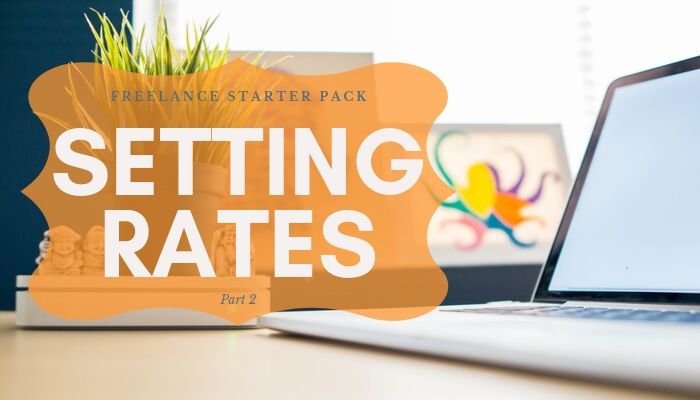Setting Rates: Freelance Starter Pack (Part 2)

A couple of years ago (man, time flies), I wrote a “Freelancer Starter Pack” blog post providing a few tips on how to find your first clients, get your finances in order from the get go, and set up an organizational system that’ll take you to success. All of this, of course, was a quick overview… which is why I promised to write more in additional parts. Now I’m living up to that promise!
*pause for applause*
Take a moment to read over part 1 (I’ve added a few updates).
Recently, someone asked me about rates – setting them, quoting them, the whole kit-and-caboodle. I, being the writer that I am, responded to the questions with an essay.
Here is that essay, edited and revised so it is a little less all over the place.
Setting Your Rates
I highly suggest you create a rate list for yourself before you pitch/quote for work. Or create a profile on a job site. Or really anything. Having a set rate list for your work from the get-go will save you a lot of headache later – and make you more confident when clients ask for quotes on projects.
Before you start developing your rate list, find out what’s happening in your industry. Look at associations, groups, online job sites and other references. For example, I frequently reference the Professional Writers Association of Canada article on writing/editing rates when considering my rates. If there isn’t a handy article like this one for your industry, create a range based on your research.
Next, decide where you stand on that range. Use your experience and educational background – are you just beginning or do you have X years experience in the industry? Have you received accreditation from a recognized school in your field? These will give you… I guess we can call it leverage… when setting your rates.
It is important to note that your potential clients may want proof of your experience and education, so be prepared to back up your rates with samples… and proof.
Now you can start crafting those numbers. To do this, first decide if you want to charge an hourly rate or flat rate for your project. You can also offer clients both options (which is what I do). There are benefits and disadvantages to both types.
Hourly Rates
How to set them
- Determine the absolute base amount you need per hour to cover everything (business expenses, basic living cost, savings plans, etc.). Use that range you developed in your research as a starting point.
- Then add 25% for your personal income tax, which you’ll have to pay/claim at tax time (at least, in Canada… not sure about other countries).
For example, if you can cover all your business expenses, basic living costs and put a little aside to save up at $25/hour (assuming an X hour work week), add 25% ($6.25) and your base hourly rate is $31.25. You can use that amount or round to the nearest one/five/10 dollar increment.
Benefits
You’ll be paid for every single hour you work.
Cons
If you quote a set number of hours for a project and go over, clients might be surprised by the charge and unhappy. (I keep clients updated on my hours worked for projects and let them know when I come close to the set project time.)
Some Additional Tips
Charge in 15 or 30 minute increments. Charging per minute can get finicky… and result in a lot of decimal amounts on invoices.
Your hourly rate can be different for different services. It’s up to you how you set them. I have different hourly rates for a myriad of things and for a variety of reasons. (I keep track of them in my project management app.)
Flat Rates
How to set them
- Start with your preferred hourly rate.
- Calculate how many hours it will take for you to complete the project (time spent varies depending on the length of a project.
- Multiply hourly rate by time spent and you have your flat rate quote.
For example: Let’s say a 500 word blog post with high research expectations takes about 1.5 hours of work (1 hour of research + 30 minutes to write); 30 x 1.5 = $45. Your flat rate for a 500 word, heavily researched blog would be $45.
Benefits
Clients will know upfront what they’ll be charged for the project.
If you go under your expected hours, you’ll make a profit. (Bonus!)
Cons
If you go over your expected hours, you’ll make less per hour than anticipated. (Boo!)
Some additional tips
When you set a flat rate and start a project with a client, track the hours you work on that project (even though you’re not charging hourly). At set times throughout the year (lets say quarterly), you can monitor how well your quotes are working (if you’re coming in right on the estimated hours, over the estimated hours or under, etc.) and reassess your flat rates with new clients and future projects.
Quoting for a project
There will come a time when a potential client will ask you how much a project will cost. Aka, they’ll ask you for a quote. Most likely, this time will come very early in your freelancing career. Here are some tips for how to quote a new project.
Speak to the client about the project.
Ask a billion questions. I mean that (though I am exaggerating the number). Here are some suggested questions to ask:
- What is their desired completion date?
- How long? (Cater this to your industry. For writers, it’s word count; for others it may be duration in days, or hours per day, etc. etc.)
- Do they have a style guide, brand guidelines, colour guidelines, etc.?
- Will you be required to research the topic/project or will the client provide the details/resources/etc.?
There are many other questions you can ask. This old (ancient, really) article has some good tips. If you’re not sure what else you’ll need to know, just Google it. That’s what I do, and it usually helps a lot.
Set two prices for yourself.
After getting all the information you can, review and set two prices for yourself – both flat rate and hourly (see above section for details on this). (The end result will be four numbers in total.)
The first set of numbers is the “lowest amount” you’ll accept. It’s important to figure this out ahead of time so that you know, for yourself, how low you can go before you lose money. Also, it keeps you from getting deer-in-the-headlights syndrome if you’re, say, on a Skype call with the potential client and they ask if you can do the project for a much lower rate than you want/anticipated.
The second number is your “desired amount” for the project. This number ensures you make a profit on the project. It’s also usually the one that you start out with in the negotiations.
Money Discussions
Start the “money discussion” by asking if they have a budget for the project.
- If they don’t have a budget…
- Provide your “desired amount” as the quote.
- I almost always tell my potential clients that the quote is negotiable.
- Sometimes clients accept right away, sometimes they say it’s too high and provide their budget, and sometimes they run away… for the second option, see below; for the third option, follow up and remind them that it’s negotiable… but usually when they run away without trying to negotiate, there’s no saving the project.
- If they do have a budget, compare their budgeted amount to your “lowest amount”.
- If their budget is higher than your “lowest amount” – great! Accept the job and hop to it.
- If their budget is lower than your “lowest amount”, quote them your “lowest amount” and see if they can swing it.
Increasing/Decreasing Rates
I review my rates once a year, usually the last week of December or first week of January. I consider this to be a very important aspect of freelancing – this is where you’ll find out if your rates are really working or if you’re short changing yourself.
Here’s what I do when reviewing my rates (my system may not work for everyone):
- First, I see if, overall, my average hourly rate is hitting the right spot – aka, the hourly rate I set for myself in the “Setting Your Rates” section.
- Calculate all of the money earned that year (after sales and personal tax but before expenses).
- Calculate total number of hours worked for the entire year.
- Divide (a) by (b) to get my average hourly rate for the year.
- If my average hourly rate is at or above my desired hourly rate, then I keep going as I have been, maybe adjusting here and there, depending on my anticipated work flow for the coming months.
- If my average hourly rate is below my desired one, then I have to dig deeper to find the “leak”. This is an in-depth audit of all my invoices and too convoluted to explain here. Ok, that’s a bit of a lie. I don’t actually know by memory how I do it… I figure it out as I go and come to a conclusion somehow! (Maybe I’ll write down HOW I do that when I do it this year.)
Whatever your “audit” result, a raise is never a bad idea – that’s why most people get them in office and salaried jobs every year! January is a good time to give yourself a raise. Set your desired hourly rate a dollar or two higher for the New Year. (I wouldn’t advise raising your rates for existing clients by more than a dollar or two.) It’ll be like a belated Christmas present.
Of course, this means increasing your rates with your clients. I have no good tips or advice for this. I tend to just email my clients with a note saying that my rates are increasing by X per hour. Every time I’ve done this, they’ve been very receptive and understanding. Hopefully yours will be as gracious!
What services to include and what not to include
Prior to being asked this question by an inquiring mind, I’d never really thought about this. I’m usually very open to helping clients with whatever they need… as long as it’s within my skill set, of course!
Ultimately, it’s up to you what you feel comfortable doing, and what you’re qualified to do. For example, I’ve never offered or included graphic design in my quotes or projects because I’m not a graphic designer. I do have designers in my network though, so I will offer to set clients up with one if they need it. Usually, this isn’t a problem. Likewise with translation work – I’m not a translator and will never take on French to English translation. A friend of mine studied it for four years in University, and it’s hard.
Offer the services you’re best at (in my case, writing, editing, proofing) and then judge based on your working experience with a client whether to offer more (web administration, back end set up, etc.)
But really, go with your gut. And don’t offer additional services until you know (and like) a client.
Well, that’s the end of my essay on setting rates. I hope this helped! Next month (or maybe the month after) I’ll publish part 3, which may or may not be on marketing yourself. If you have any additional tips or questions about setting rates as a freelancer, leave them in the comments!

 Previous Post
Previous Post Next Post
Next Post